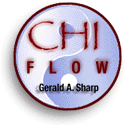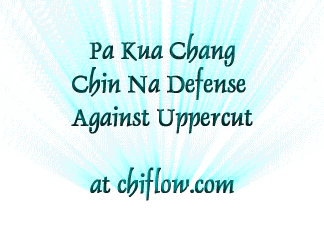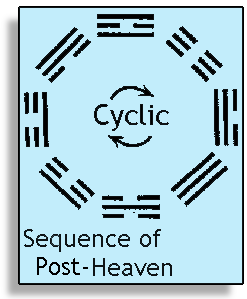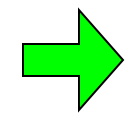Baguazhang and Pa Kua Chang are different English translation schemes for the same Eight Trigrams Palm martial art. It is linked to the teachings of Tung Hai Chuan (Dong Hai Quan, 1797-1882 A.D.). Pa Kua Chang is often associated with Taoist practices including circle walking.
Pa-Kua Chuan, or Eight Trigrams Palm, is built on two symbols referred to as Pre-Heaven and Post-Heaven Trigrams. A philosophical understanding of these two symbols, their aspects and their properties, can lead one to discover the multiple aspects that lay beyond even the basic 64 hexagrams.
The purpose of Pa-Kua Chang (Eight Diagrams Palm) practice is to harmonize the aspectswithin ourselves associated with these two symbols to advance ourselves mentally, physically, and spiritually. When the student is able to harmonize the polar aspects of the Pre-Heaven symbol with the cyclic aspects of the Post-Heaven symbol, the student really can grasp not only the free style application of the art, but the curved line of the Tai Chi symbol. For it is the curved line, or S Curve, which is the combination of the polar and cyclic aspects.
|
1. The Pre-Heaven Diagram The Pre-Heaven Eight Trigrams were supposedly developed by the Emperor Fu Hsi around the year of 2900 B.C. Legend has it that Fu Hsi received his inspiration as a gift from a flying dragon that came out of the Yellow River. Fu Hsi, may or may not have been the original developer of the Pre-Heaven Pa-Kua. Legend further has it that he taught the people of the early Yellow river civilization how to cook and live in harmony with nature. The Pre-Heaven symbol is thought to have developed from an earlier explanation of the five elements developed from the five phases, or elements of: Metal, Water, Wood, Fire, and Earth. With the emphasis of living in harmony with nature it was thought that Metal gave birth to Water, Water gave birth to Wood, Wood gave birth to Fire, Fire gave birth to Earth, Earth gave birth to Metal, Metal gives birth to Water and so on cyclically. The symbol lays out polar opposites with Heaven above Earth, Fire opposite Water, Thunder separate from Wind, Lake is concave in the Earth's surface, while the Mountain is convex in the surface. According to legend, the early times on the Yellow River Valley were harmonious and peaceful. Furthermore, the climate was more gentle and people lived simple and longer lives. |
2. The Pre-Heaven Diagram
|
|
3. The Post-Heaven Diagram This legend continues that around 2200 B.C. the climate began to change and flooding became more prevalent along the banks of the Yellow River. Also around this time a new symbol was supposedly developed by the Emperor Yu. This symbol was used to offer answers and explanations for the changes that had happened to Fu Hsi's harmonious world. The Emperor Yu claimed he could control the climate and prevent or anticipate flooding along the Yellow River with the knowledge and magic afforded him by his new symbol. Emperor Yu supposedly discovered his magic numbering system arranged on the back of a tortoise. This numbering system came to be known as the Magic Tortoise or Magic Square, while the new symbol came to be known as the Post-Heaven Pa-Kua symbol. Finally, according to this legend, around 1100 B.C. Wen Wang, or King Wen, devised deeper explanations to the trigrams and hexagrams while studying the diagrams during his imprisonment under Emperor Chou. This work became known as the "Canon of Changes," or the "I-Ching." The Post-Heaven symbol is thought to be based on the destructive order of the five elements: Metal splits Wood, Wood restricts Earth, Earth limits Water, Water conquers Fire, Fire shapes Metal, Metal splits Wood, and so on cyclically. |
4. The Post-Heaven Diagram
|
|
5. History, Legend and Tung Hai Chuan The beginnings of Pa-Kua Chang are as obscure as the origin of the I Ching itself. Most modern day records indicate that the developer of modern day Pa-Kua Chang was Tung Hai Chuan (Dong Hai Quan, 1797-1882 A.D.). Many colorful legends surround the great Tung who supposedly first displayed his art to the Emperor while serving as a eunuch in the emperor's palace. Tung supposedly became a monk in a Taoist temple, because he was on the run from authorities. Later he was expelled from the temple for improper behavior, and went to Beijing where he posed as a eunuch by sneaking into the Emperor's palace. To go past palace guards undetected in those times was considered to be impossible to do. However, Tung's great acrobatic skill and ease of maneuverability, made it easy for him to supposedly come and go from the palace as he wished. Legend further has it, that the Emperor heard that Tung was able to sneak in and out of the palace at will, and that Tung possessed great martial art skill. The emperor asked Tung Hai Chuan to give a public demonstration. After the demonstration, the emperor was so impressed that he asked that Tung teach the palace guards his Kung Fu skills. Some accounts of the development or creation of Pa-Kua Chang point to Tung Hai Chuan having a teacher. There is little doubt Tung Hai Chuan did have a teacher. However, who his teachers werer, or what he may have studied is not clear. It is possible that Taoist monks, who are credited with having developed some external and internal martial arts, may have adapted martial arts to the polarity or cyclical aspects of the I-Ching many years before Tung Hai Chuan was born. At any rate, Tung Hai Chuan is widely recognized as the father of modern Pa-Kua Chang by many written and oral accounts. He had many great students including: Yin Fu, Cheng Ting Hua, Zhang Zhao Dong, Li Cun Yi, Liu Feng Chun, Liang Zhen Pu, and others. |
6. Tung Hai Chuan
Tong Hai Chuan |
|
7. Baguazhang and Xingyiquan - Dong Hai Quan and Guo Yun Shen Another legend involves the famous Hsing-I master Guo Yun Shen. Guo is said to have had an extremely powerful Beng Chuan (Bursting fist). It is said that he killed a man while in prison (for accidentally killing another man) with both hands in irons with his Beng Chuan technique. Upon his release from prison he had heard of Dong Hai Chuan's prowess as a martial artist and he wanted to test his skills. For three days and nights the two masters tried vigorously to defeat the other in a match. They found at least as many similarities as differences in their two arts. As these reknown masters were not able to defeat each other, neither art could be shown to be superior to the other. The legend goes that the two teachers decided that they would each teach the other's students to allow the students to study both arts. So, from that time on until the present, it is not unusual to see Pa-Kua Chang practitioners become excited and engaged in a deep study of Hsing-I Chuan and vice-a-versa. |
8. Martial Applications of Pa Kua Chang Check out these related pages featuring applications and information on Baguazhang and Xingyiquan:
Go on to the Overview of Pa Kua Chang, Part 2 |








